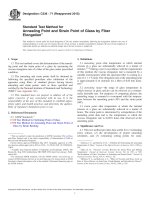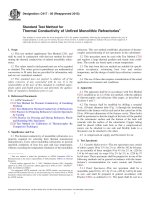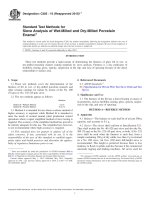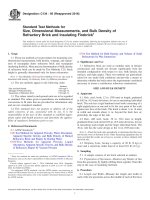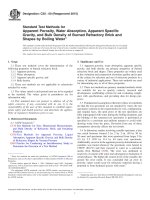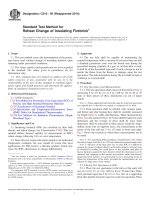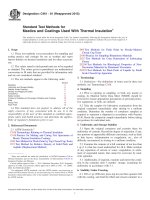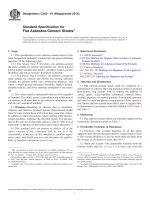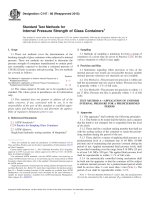Astm c 92 95 (2015)
Bạn đang xem bản rút gọn của tài liệu. Xem và tải ngay bản đầy đủ của tài liệu tại đây (76.72 KB, 4 trang )
Designation: C92 − 95 (Reapproved 2015)
Standard Test Methods for
Sieve Analysis and Water Content of Refractory Materials1
This standard is issued under the fixed designation C92; the number immediately following the designation indicates the year of original
adoption or, in the case of revision, the year of last revision. A number in parentheses indicates the year of last reapproval. A superscript
epsilon (´) indicates an editorial change since the last revision or reapproval.
This standard has been approved for use by agencies of the U.S. Department of Defense.
2. Referenced Documents
1. Scope
2.1 ASTM Standards:2
C429 Test Method for Sieve Analysis of Raw Materials for
Glass Manufacture
E11 Specification for Woven Wire Test Sieve Cloth and Test
Sieves
E105 Practice for Probability Sampling of Materials
E122 Practice for Calculating Sample Size to Estimate, With
Specified Precision, the Average for a Characteristic of a
Lot or Process
2.2 Other Document:
ASTM STP 447 Manual on Test Sieving Methods3
1.1 These test methods cover a wet and a dry method for
sieve analysis of refractory materials.
1.1.1 Wet Sieve Analysis—Water promotes the slaking of
clays and helps to separate fine particles, washing them from
the larger grains. This method is recommended for use with
materials that require water addition, and that slake in normal
industrial use.
1.1.2 Dry Sieve Analysis—The dry method is not as effective as the wet method in determining the amount of material
present in the smaller particle sizes. It is recommended (1) for
clays, when the slaking action of water is undesirable, (2) when
the material is in the form of coarsely ground grog and calcine,
and (3) when the clay is to be used in such a way that the
ultimate particle size is of secondary importance.
3. Significance and Use
3.1 Particle size distribution has a major affect upon most of
the refractory properties. These test methods provide a means
of measuring the distribution for the purpose of comparison to
the desired distribution.
1.2 These test methods also cover determination of the
water content of refractory materials in the wet condition and
of air-dried samples as received, so that the sieve analysis can
be calculated on the dry basis. Included is a method for
obtaining the water content of other refractory materials, such
as plastic refractories and wet mixes.
3.2 These test methods also cover determination of the
water content of refractory materials in the wet condition and
of air-dried samples received, so that the sieve analysis can be
calculated on the dry basis.
1.3 The values stated in inch-pound units are to be regarded
as standard. The values given in parentheses are mathematical
conversions to SI units that are provided for information only
and are not considered standard.
1.4 This standard does not purport to address all of the
safety concerns, if any, associated with its use. It is the
responsibility of the user of this standard to establish appropriate safety and health practices and determine the applicability of regulatory limitations prior to use.
3.3 These methods can produce data for specification
acceptance, design purposes, manufacturing control, and research and development.
3.4 A reference set of standard matched or calibrated sieves4
shall be provided for use in checking the set of sieves used in
2
For referenced ASTM standards, visit the ASTM website, www.astm.org, or
contact ASTM Customer Service at For Annual Book of ASTM
Standards volume information, refer to the standard’s Document Summary page on
the ASTM website.
3
Available from ASTM International, 100 Barr Harbor Drive, West
Conshohocken, PA 19428.
4
The sole source of supply of matched sieves known to the committee at this
time is W. S. Tyler, Inc., Mentor, OH 44060. If you are aware of alternative
suppliers, please provide this information to ASTM International Headquarters.
Your comments will receive careful consideration at a meeting of the responsible
technical committee,1 which you may attend.
1
These test methods are under the jurisdiction of ASTM Committee C08 on
Refractories and are the direct responsibility of Subcommittee C08.03 on Physical
Properties.
Current edition approved March 1, 2015. Published April 2015. Originally
approved in 1943. Last previous edition approved in 2010 as C92 – 95 (2010). DOI:
10.1520/C0092-95R15.
Copyright © ASTM International, 100 Barr Harbor Drive, PO Box C700, West Conshohocken, PA 19428-2959. United States
1
C92 − 95 (2015)
WET SIEVE ANALYSIS
the actual sieve analysis of samples. The sieves for use in sieve
analysis may also be standard matched sieves or may be
unmatched sieves conforming to the Specification Table in
Specification E11, provided that such sieves will give results
that differ by no more than 5 % from those obtained with the
reference set when the two sets are compared in accordance
with the section of Test Method C429 on testing of sieves and
samples splitters.
6. Dry Materials
6.1 If the material is received in the dry condition, the test
specimen (Note 1) shall consist of the dried and weighed test
specimen prepared in accordance with 5.2.2.
NOTE 1—The size of the test specimen may be changed by reason of the
nature of the material. For example, some clays tend to pack or cake on
the sieves when ground to exceedingly fine particle size, in which case a
100-g sample may be used. For plastic refractories or coarsely ground
mixes, the weight of the specimen could be increased to 500 g.
4. Apparatus
4.1 ASTM sieves, or the equivalent Tyler Series listed in
Table 1, shall be used. The wire cloth for the sieves, described
in Specification E11, shall be woven (not twilled) and mounted
without distortion or looseness in 8-in. (200-mm) diameter
circular frames. Pans and covers shall be provided for the
sieves.
7. Wet Materials
7.1 Materials prepared with water (plastic refractories, wettype high-temperature bonding mortars, etc.) shall be tested as
received. Take two test specimens immediately after opening
the original container and, in the case of mortars, after carefully
mixing the contents. Use one specimen for determining the
water content in accordance with either 5.2.1 or 5.2.2. Obtain
approximately 250 g of the other specimen (Note 1) for sieve
analysis. Weigh the test specimen to the nearest 0.1 g and
transfer to the 1-dm3 container (see Section 8). Wash the
utensils used during weighing (to which a small part of the
sample may adhere) with a small jet of water from a 1⁄4-in.
(6-mm) hose to ensure a quantitative transfer of the weighed
specimen to the container.
5. Sampling, Test Specimens, and Test Units
5.1 A representative sample of the material to be tested shall
weigh at least four to five times the required weight of the
actual test specimen. Material on which the water content is to
be determined shall be packed in a watertight container.
5.2 Water Content:
5.2.1 Wet-Type Air-Setting Refractory Mortars—Remove
approximately 50 g of the material immediately after opening
the original container and after carefully mixing the contents.
To facilitate handling the specimen, place it on a tared piece of
waxed paper or aluminum weighing dish. Weigh the test
specimen to the nearest 0.1 g both before and after drying for
24 h at 220 to 230°F (105 to 110°C). Calculate the percentage
of water to the nearest 0.1 % on the as-received basis.
5.2.2 Materials Other Than Wet-Type Air-Setting Refractory
Mortars (ground fire clays, fireclay mortars, dry-type airsetting mortars, plastic refractories, and similar materials)—If
the material is shipped in the wet condition, prevent loss of
water before obtaining a test specimen of approximately 250 g.
Weigh the test specimen to the nearest 0.1 g both before and
after drying for 3 h at 220 to 230°F (105 to 110°C). Calculate
the percentage of water to the nearest 0.1 % on the as-received
basis. The dried specimen may be required for further tests (see
Sections 6 and 7).
8. Procedure
8.1 Place the test specimen into a container of about 1-dm3
capacity. Add sufficient water to form a slurry. Allow slaking to
proceed for 1 h, after which a further addition of water may be
necessary. Then transfer the test specimen (without loss) to the
finest sieve to be used in the analysis. Wash with a small jet of
water from a 1⁄4-in. (6-mm) rubber hose until the water passing
through the sieve contains only traces of the specimen.
Exercise care during washing to prevent loss by splashing. It
may be necessary to break up lumps by gently rubbing between
the fingers, but never by rubbing or pressing against the sieve.
Then dry the washed residue in the sieve to constant weight at
220 to 230°F (105 to 110°C). This usually requires about 2 h.
If desired, a preliminary drying period at a lower temperature
may be used. Then transfer the dried residue to the top or
coarsest sieve of the series to be used. Complete the sieving
and weighing operations in accordance with Section 10 or 11.
TABLE 1 ASTM Sieves and the Equivalent Tyler Standard Series
0.265 in.
4
6
8
12
16
20
30
40
50
70
100
140
200
Tyler Standard Series
(Mesh Designation)
Sieve Opening
3
4
6
8
10
14
20
28
35
48
65
100
150
200
6.7 mm
4.75 mm
3.35 mm
2.36 mm
1.70 mm
1.18 mm
850 µm
600 µm
425 µm
300 µm
212 µm
150 µm
106 µm
75 µm
9. Calculation and Report
9.1 Calculate the wet sieve analysis for the test specimen on
the dry weight, and report the results to the nearest 0.1 % of the
material retained on each sieve (Note 2). Report the percentage
passing the finest sieve as the difference between 100 % and
the sum of the percentages retained on the other sieves.
NOTE 2—As an alternative, the results of sieve analysis may be reported
on the cumulative basis, either as the total percentage retained on or
passing each sieve.
DRY SIEVE ANALYSIS
10. Mechanical Sieving
10.1 When the sieving is to be done mechanically, arrange
the sieves in the order of size with the coarsest sieve at the top
2
C92 − 95 (2015)
TABLE 2 Precision
of the series. The specimen for sieving (Note 1) shall consist of
a dried and weighed material prepared in accordance with
5.2.2. Transfer the specimen to the top sieve of the series, and
mechanically sieve until less than 0.1 g passes through each
sieve after hand sieving for 1 min, as described in Section 11.
The machine-sieving operation usually requires about 15 min.
Then carefully separate the sieves and determine the amount of
material retained on each by weighing to the nearest 0.1 g.
Material
Tabular alumina
(−2.5× 28 m)
SiC (−14 m)
Grand average
Wet mortar
(28 × 150 m)
(−150 m)
11. Hand Sieving
11.1 The specimen for sieving (Note 1) shall consist of a
dried and weighed material prepared in accordance with 5.2.2.
Use one sieve at a time beginning with the coarsest and then
successively to finer sizes. Alternately tap and rotate the sieve,
with pan and cover attached, while holding it in a slightly
inclined position so that the test sample will be well distributed
over the sieve. Continue the operation until less than 0.1 g of
the material passes through each sieve during 1 min of
continuous sieving. Determine the amount of material retained
on each sieve by weighing to the nearest 0.1 g.
Water content
Average
Difference
from Grand
Average X
Standard Deviation WithinBetween
RepeatabilityReproducibility
Intervals
Sr
SL
Ir
IR
0.74
0.064
0.293
0.18
0.85
0.70
0.72
0.35
0.059
0.062
0.123
0.306
0.300
0.0221
0.17
0.175
0.35
0.88
0.865
0.35
1.25
Average
12.4
0.860
0.700
2.40
3.10
0.11
1.15
0.31
3.25
TABLE 3 Relative Precision
Material
Tabular alumina
SiC
Average
Wet mortar
(28 × 150)
(−150 m)
H2O content
12. Calculation and Report
12.1 Calculate the dry sieve analysis for the test specimen
on the dry weight, and report the results to the nearest 0.1 % of
the material retained on each sieve (Note 2). Include dust loss
with the material passing the finest sieve.
Coefficient of Variation
Within-Between
Repeatability-Reproducibility Intervals
Vr
VL
% Ir
% IR
8.7
8.4
8.6
39.8
43.7
41.8
24.7
23.7
24.2
115.1
125.8
120.5
34.7
68.6
0.88
5.9
56.0
9.2
98.2
194.0
2.5
99.6
250.4
26.2
difference was similar for the dry tabular alumina and silicon
carbide. The standard deviations of the average difference were
slightly greater for the dry-sieved portion (+150 mesh) and
much greater for the wet-sieved portion (−150 mesh) of the wet
mortar.
13. Precision and Bias
13.1 Interlaboratory Testing—An interlaboratory study was
conducted among seven laboratories in 1986. The same
samples of −2.5, +28 mesh tabular alumina and −14 mesh
silicon carbide were tested by each laboratory to eliminate
sampling variability. A third material, wet bauxite mortar, was
split into separate samples for each laboratory for wet sieve
analysis and moisture content tests.
13.1.1 The sponsoring laboratory used matched sieves and
ran the initial and final dry sieve analyses on the tabular
alumina and the silicon carbide samples in order to evaluate
sample loss or sample breakdown in the repeated runs. The
total specimen loss at this end of the study was 3.7 % of the
tabular alumina and 4.3 % of the silicon carbide. Each of the
other 6 laboratories, with one exception, ran two repetitions on
each specimen. Thus, a total of seven sets of data with two
replicates each and one set of data with one replicate were
analyzed.
13.1.2 The wet mortar results consisted of one set of data
from each of six laboratories. Each set of data included sieve
analyses and water content on two separate samples split from
the main sample received by each laboratory.
13.1.3 Analysis of the sieve analyses data was based on the
positive accumulated difference (PAD), which is the sum of the
absolute values of the difference between the percent held on
each sieve in one repetition and the grand average of the
percent on each sieve for all repetitions. The PAD divided by
the total number of sieves within the particle size range of the
particular material gave the average PAD per sieve. Hereafter,
the value will be referred to as the average difference.
13.1.4 As shown in Table 2 and Table 3, the standard
deviations within and between laboratories for the average
13.2 Precision:
13.2.1 Precision is based on the average difference only. For
dry sieve analyses in one laboratory, the average difference for
two materials is significantly different at a probability of 95 %
(t = 1.96) if it exceeds the repeatability (Ir) listed for precision
in Table 2 or for relative precision (% Ir) in Table 3. That is, the
average difference between two sieve analysis on the same
material obtained in the same laboratory will be expected to
exceed the Ir value only about 5 % of the time. If the average
difference exceeds Ir, there is reason to question the test results.
Likewise, the average difference for two materials obtained by
two laboratories is considered to be significantly different if it
exceeds the applicable reproducibility intervals (IR and % IR)
in Table 2 and Table 3.
13.2.2 The precision of the sieve analysis of wet materials is
treated in two parts, the dry-sieved +150 mesh and the
wet-sieved −150 mesh. For dry sieve analyses in one
laboratory, the average difference for two materials is significantly different at a probability of 95 % (t = 1.96) if it exceeds
the repeatability intervals listed for precision in Table 2 or for
relative precision in Table 3. Likewise for comparing the
average differences of two wet materials tested in two laboratories.
13.2.3 The precision and relative precision for the water
content of wet materials are shown in Table 2 and Table 3,
respectively, and are used in the same fashion as described in
13.2.2.
3
C92 − 95 (2015)
13.3 Bias—No justifiable statement on bias can be made
since the true values for particle size and water content of
different materials cannot be established by an accepted reference method.
14. Keywords
14.1 dry sieve analysis; refractories; water content; wet
sieve analysis
ASTM International takes no position respecting the validity of any patent rights asserted in connection with any item mentioned
in this standard. Users of this standard are expressly advised that determination of the validity of any such patent rights, and the risk
of infringement of such rights, are entirely their own responsibility.
This standard is subject to revision at any time by the responsible technical committee and must be reviewed every five years and
if not revised, either reapproved or withdrawn. Your comments are invited either for revision of this standard or for additional standards
and should be addressed to ASTM International Headquarters. Your comments will receive careful consideration at a meeting of the
responsible technical committee, which you may attend. If you feel that your comments have not received a fair hearing you should
make your views known to the ASTM Committee on Standards, at the address shown below.
This standard is copyrighted by ASTM International, 100 Barr Harbor Drive, PO Box C700, West Conshohocken, PA 19428-2959,
United States. Individual reprints (single or multiple copies) of this standard may be obtained by contacting ASTM at the above
address or at 610-832-9585 (phone), 610-832-9555 (fax), or (e-mail); or through the ASTM website
(www.astm.org). Permission rights to photocopy the standard may also be secured from the Copyright Clearance Center, 222
Rosewood Drive, Danvers, MA 01923, Tel: (978) 646-2600; />
4

